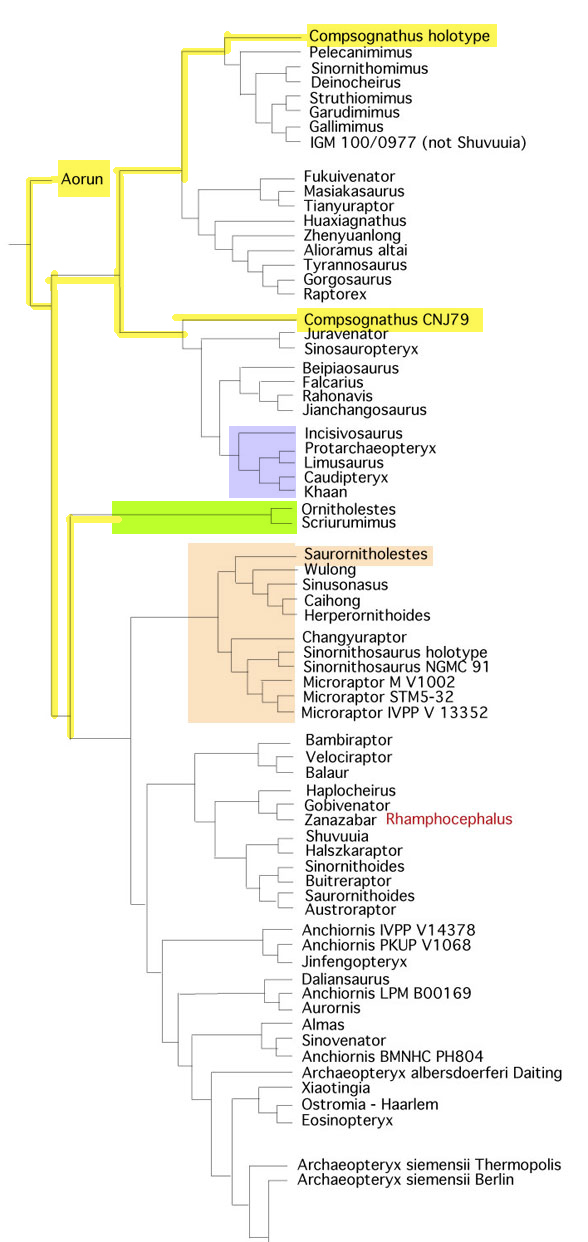Chapelle et al. 2021 report:
“Ornitholestes hermanni was one of the first small-bodied theropods named in the 1900s.”
Here in the large reptile tree (LRT, 1991 taxa; subset Fig. 2) Late Jurassic Ornitholestes (Fig. 1) nests as a large basal compsognathid along with tiny Sciurumimus. Aorun is a last common ancestor and similar in size to Ornitholestes.
Chapelle et al. continue:
“It is known from a single specimen discovered during the American Museum Expedition of 1900, at the Jurassic Morrison Formation site known as Bone Cabin Quarry, in Wyoming. It has long been a critical taxon in understanding the evolution of the Coelurosauria, the clade that includes tyrannosauroids, living birds, and their common ancestors.”
In the LRT (Fig. 2) tyrannosaurs are not proximal outgroups to birds (perhaps Chapelle was just being inclusive). In any case the Coelurosauria was named by von Huene in 1914. In the LRT it is a junior synonym for Compsognathidae (= Compsognathus and its ancestors) named by Cope in 1871, 43 years earlier. Coelurosauria is in common usage so it continues to be used here.
Chapelle et al. continue:
“The holotype specimen comprises a nearly complete skull and most of a postcranial skeleton. Despite this abundant material, its precise phylogenetic relationships have been difficult to determine.”
Not in the LRT (subset Fig. 2) where Ornitholestes is a transitional taxon between the ‘more primitive’ compsognathids and the ‘more derived’ compsognathids (= Panaves = Eumaniraptora).
Chapelle et al. continue:
“This is in part due to the intense mediolateral crushing of the skull and the relatively generalized postcranial anatomy. Here we present the results of a micro-computed tomography based investigation of the cranial anatomy and subsequent incorporation of these data into a phylogenetic data matrix designed to test coelurosaurian interrelationships.”
According to Wikipedia:
Coelurosauria = theropod dinosaurs closer to birds than to carnosaurs.
Carnosauria = allosaurs and their kin. In the LRT (Fig. 2) these taxa precede Aorun.
“We find robust evidence across different optimality criteria that Ornitholestes is the earliest-branching oviraptorosaurian species.”
In the LRT (Fig. 2) Ornitholestes is not basal to the oviraptor clade.
“Using parsimony as an optimality criterion, this phylogenetic position is supported by 14 unambiguous synapomorphies, including: a short frontal process of the postorbital; short, deep, and pendant paroccipital processes; a large mandibular foramen; an anterodorsally
oriented dentary symphysis; a surangular that is longer than the dentary; short maxillary and dentary tooth rows; and procumbent dentary and premaxillary teeth.”
We will need to see the taxon list and the scoring. All or most of these traits may be convergent. Note the authors are not mentioning any basal oviratorids closest to Ornitholestes nor any proximal outgroups. These should be reported.
“Using Bayesian fossilized birth-death models, we find high posterior probabilities (>.99) that Ornitholestes is the earliest-branching oviraptorosaurian species.”
Maybe. Maybe not. µCT scans are no substitute for minimizing taxon exclusion by adding more and more taxa.
“We additionally find strong support in both analyses that the superficially bat-like and possibly arboreal scansoriopterygids are an early branching lineage within Oviraptorosauria.”
Chapelle et al. just let us know they are excluding taxa.
Scansoriopterygids are birds in the LRT. Many are flightless. None are bat-like.
“This new phylogenetic position fills in a persistent ghost lineage in Oviraptorosauria and confirms that scansoriopterygids are basally branching oviraptorosaurians that represent an independent origin of aerial habits, separate from those of dromaeosaurs and avialans.”
Suggestions to Chapelle et al.: Add taxa (especially more Solnhofen birds) and take another look at those broken wing bones in scansoriopterygids
References
Chapelle et al. 2021. A CT-based revised description and phylogenetic analysis of the skull of the basal maniraptoran Ornitholestes hermanni Osborn 1903. Society of Vertebrate Paleontology abstracts: 81.


